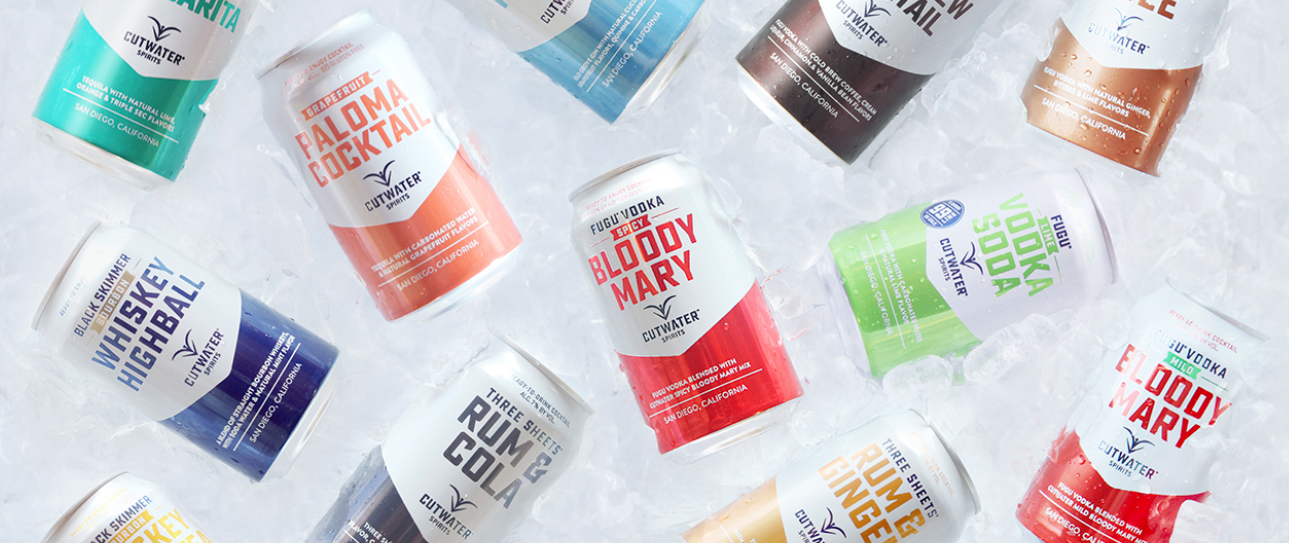THE GIST
Anheuser-Busch InBev's latest acquisition is only tangentially connected to beer. The multinational company announced this week plans to fully acquire Cutwater Spirits, a maker of mixed drinks, canned cocktails, and a variety of whiskeys, vodkas, gins, and rums. The San Diego-based company was founded by former Ballast Point executives, who now have the rare claim of having sold two alcohol businesses to two of the largest players in the world. Ballast Point's beer production was sold for a reported $1 billion in 2015 to Constellation Brands, and now there’s this sale for an undisclosed sum.
Cutwater distributes to 34 states, and, according to reporting from Brewbound, experienced 203% volume growth from Jan. 26, 2018 to Jan. 26, 2019. With the addition of the spirits company, AB InBev now features a full portfolio of alcohol options between flavored malt beverages (Ritas and Bon & Viv hard seltzer) and wine (Babe Rosé). It also owns Hiball energy drinks.
“We are first and foremost a beer company,” Brendan Whitworth, Anheuser-Busch’s vice president of sales in North America, told Brewbound. “That being said, we want to be sure we are present where all consumers are. That includes adjacencies within beer, and different segments that are emerging.”
By virtue of sheer volume, Whitworth’s comment is correct. But with Bud Light (-14.7% IRI-tracked volume 2014-2018, -6.4% 2017-2018) and Budweiser (-15.2% 2014-2018, -5.4% 2017-2018) suffering among an entire beer category that continues to have trouble moving volume, diversification makes sense.
In his conversation with Brewbound, Whitworth added that Cutwater's canned cocktails and the purchase of the company offer "an innovative and disruptive approach."
That latter adjective may sound familiar, as "disruptive" has for years been the key term for AB InBev's strategy behind ZX Ventures, the investment arm that was meant to turn the beverage industry on its head for the world's largest beer company. Instead, ZX’s focus has shifted to supporting growth of AB InBev's products.
WHY IT MATTERS
So, remember when some of the owners of AB InBev's craft breweries spoke out about the Brewers Association's seal of independence and Walt Dickinson said the beer industry should band together against the "armada" of wine and spirits coming for beer and people laughed at him because they thought it was manufactured drama? Meanwhile, craft brewers have also been dabbling in cider and wine and spirits and hard seltzer, and the Brewers Association had to change its own definition of "craft brewer" so some of the largest breweries in the country could still be considered “craft?” Also meanwhile, AB InBev has been busy investing in non-beer alternatives like energy drinks and hard seltzer and wine and now spirits?
This is getting awkward.
We can—or at least should—all admit that beer in 2019 is weird. And, most importantly, the beer industry isn't just about beer anymore. In capitalism, there may be no purity of product, but there is in dollars and cents. InBev’s continued investment in the non-beer side of things reflects the buying power of a conglomerate of its global scale. When beer is struggling, it’s a matter of money—and appeasing shareholders—to simply find volume wherever possible. In 2017, during the tail-end of its craft brewer buying spree, the narrative was about saving beer. More recently, it’s about focusing on a post-beer world where the company believes 20% of its total sales volume will come from low- or no-alcohol products.
In beer, like any other business, sometimes you just need to cover all the bases.
In the 10-year stretch from 2008-2017, the latter representing the latest year of data available for wine, liquor, and beer sales, beer is lagging way behind. Serving sizes represent the most apple-to-apple comparison between the options due to different levels of alcohol content and how figures are reported to the government, with wine at 5 ounces, liquor at 1.5 ounces, and beer with 12 ounces. Based on those definitions, liquor has seen a 26.1% increase in servings and wine has grown 16.2%. Beer sits at -4.1% in that timespan, based on data reported to a variety of public and private organizations.
It’s all created a situation in which AB InBev and Brewers Association-defined “craft” brewers alike have been identifying areas outside of beer to maintain or strengthen business opportunities. From roasting coffee to creating different alcohols, the ways to stay in the black have become more diversified, but there’s also a subtle hint about the importance of chasing Millennials, who are increasingly exploratory customers and comprise the most important consumer group for beer and other beverages.
“This is the time to really do our best to dominate a new category,” Marina Hahn, Anheuser-Busch’s New Business Co-Founder told the San Diego Tribune. And based on changes to the Brewers Association’s definition for its own member “craft breweries,” even the smallest and most independent companies can see this as a viable avenue moving forward.
As a beverage, beer is its own standalone experience. But as an industry, its path forward is starting to branch out in directions never before expected. Where we’re going, there are no categories.


